Abstract
A simplified microbiological assay for determining the folate content of red cells is described. As in previously reported methods Lactobacillus casei is used as test organism but two modifications are introduced. First, haemolysis is carried out in water containing 1 g.% of ascorbic acid; secondly, haemolysates are not incubated before the assay. Using this assay, recovery of pteroylglutamic acid added in two different concentrations to five different whole blood samples was 97·0 ± 1·9 S.E. % and 106·1 ± 4·7 S.E. % respectively. The coefficient of variation of the assay was between 11·2 and 15·0%.
Haemolysates were best stored deep frozen, showing no significant loss of L. casei activity for three to five months at −20°C. On the other hand, non-haemolysed blood samples were best stored at 4°C. when there was no loss of activity for seven to 10 days.
Experiments confirmed that plasma is necessary for the maximum release of red cell L. casei activity, and showed that only small amounts of plasma are necessary; folate- and B12-deficient plasma released slightly lower L. casei activities from red cells than did normal plasma.
The red cell folate levels of 40 healthy normal subjects ranged from 160 to 640 mμg. per ml. of packed red cells. One hundred and twenty patients with subnormal serum folate levels due to idiopathic steatorrhoea, nutritional folate deficiency and Crohn's disease, partial gastrectomy, myelosclerosis, and polycythaemia vera were studied. Red cell folate levels were subnormal (range from 7 to 143 mμg. per ml.) in 40 patients with megaloblastic anaemia, the lowest levels occurring in the most anaemic patients. Subnormal red cell folate levels also occurred in 23 (29%) of the 80 non-anaemic patients. There was a good correlation between red cell folate level and severity of folate deficiency assessed by polymorph nuclear lobe counts, and, in the non-anaemic patients bone marrow morphology. It is concluded that, in the absence of B12 deficiency, the red cell folate level is a precise guide to the severity of folate deficiency.
Patients with serum folate levels less than 3·0 mμg. per ml. almost always had megaloblastic anaemia or obvious morphological changes of folate deficiency. In patients with borderline serum folate levels (3·0-5·9 mμg. per ml.) haematological changes varied widely. The degree of change correlated with the red cell folate level in these patients.
The formiminoglutamic acid (Figlu) test was positive (range 20-660 mg. excreted in eight hours) in all 30 patients with megaloblastic anaemia due to folate deficiency tested and also in 17 (31%) of 54 non-anaemic patients who were folate deficient. The amount of Figlu excreted paralleled the red cell folate level in both the anaemic and non-anaemic, folate-deficient patients tested. Figlu excretion, like the red cell folate level, appeared to be a satisfactory index of tissue folate stores.
In 46 patients with pernicious anaemia, the red cell folate levels ranged from 26 to 396 mμg. per ml., 29 (63%) of them having subnormal levels. The ratio of mean red cell to mean serum folate level, 13·0:1, was lower than that of normal subjects. As in folate deficiency the patients with the lowest haemoglobin concentrations had the lowest red cell folate levels. Figlu was positively excreted in 10 (59%) of 17 patients with pernicious anaemia tested, being particularly increased in those with low red cell folate levels.
Reticulocytes of patients with pernicious anaemia on treatment and with haemolytic anaemia were shown to have higher folate levels than their corresponding mature cells. It is concluded that reticulocytes in general have relatively high folate levels.
Full text
PDF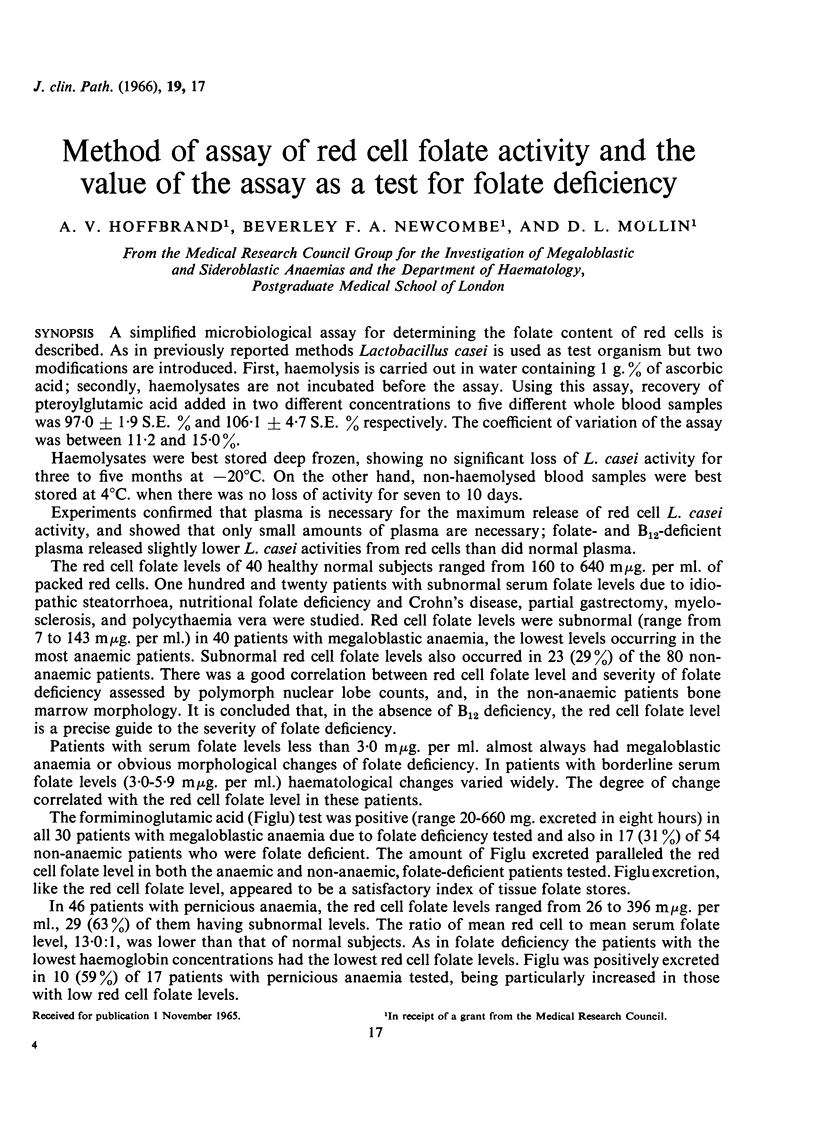
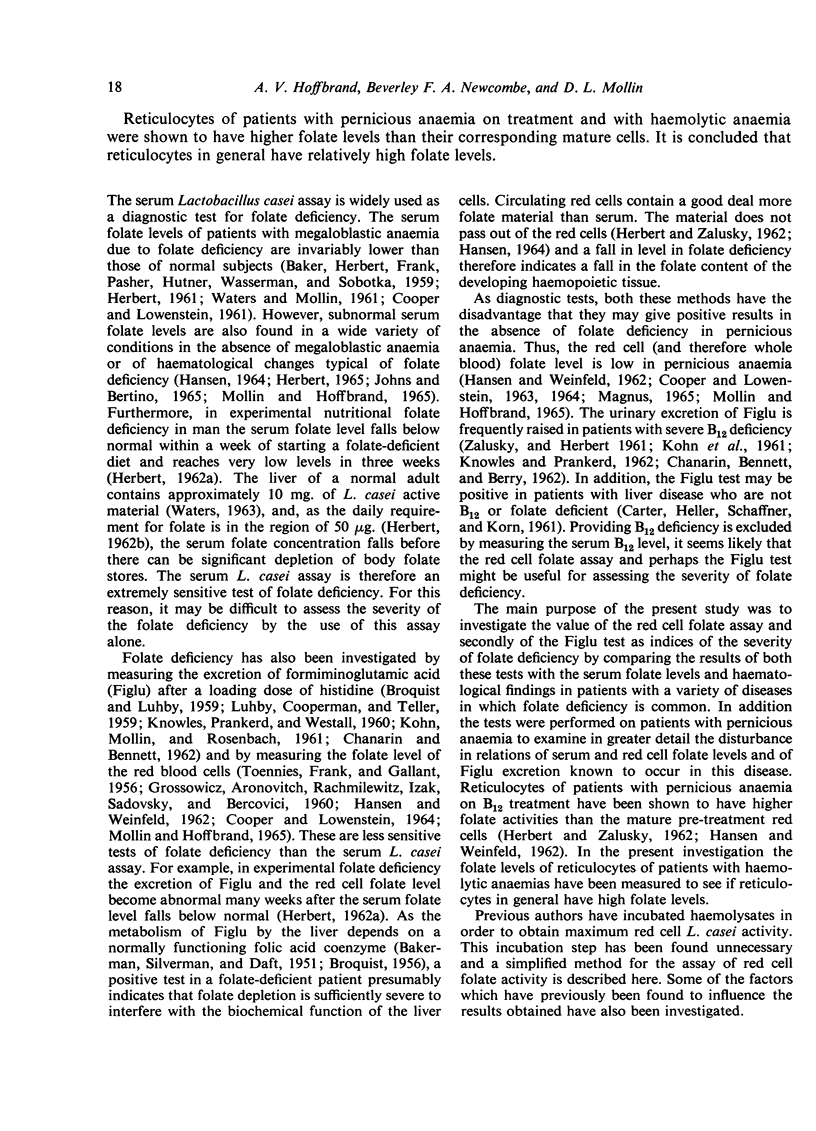
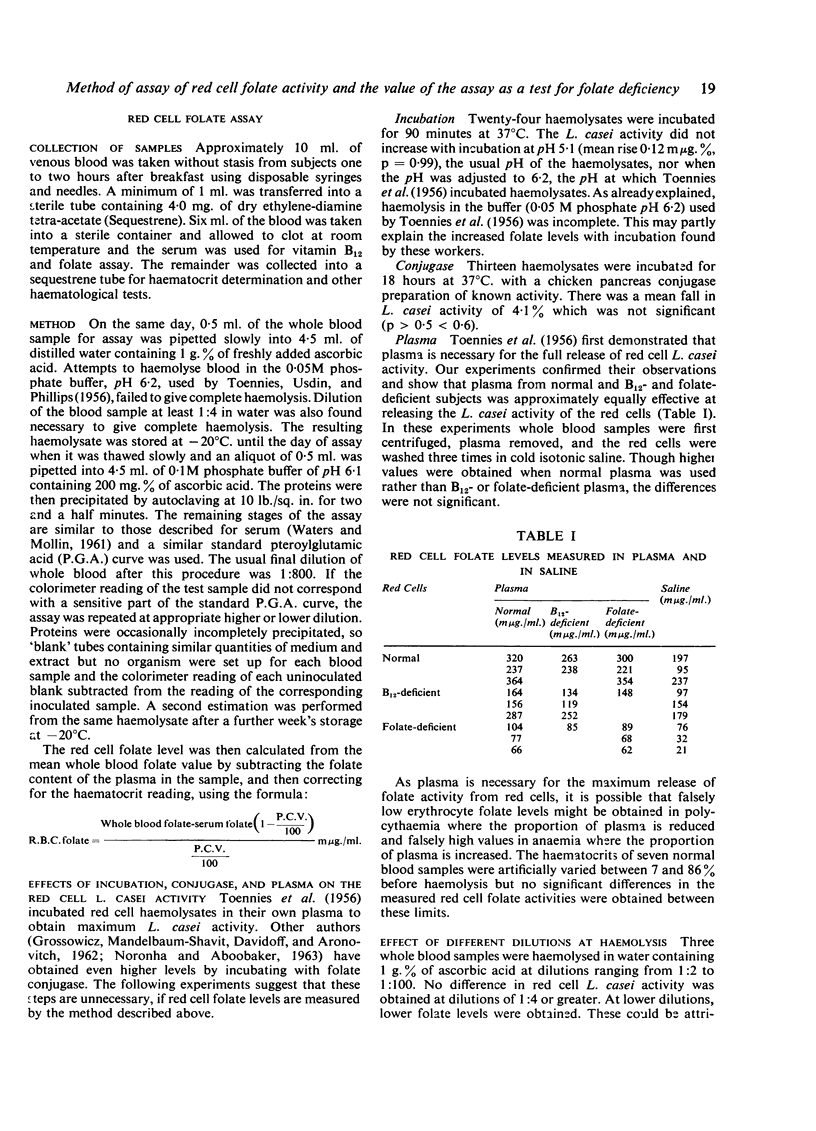
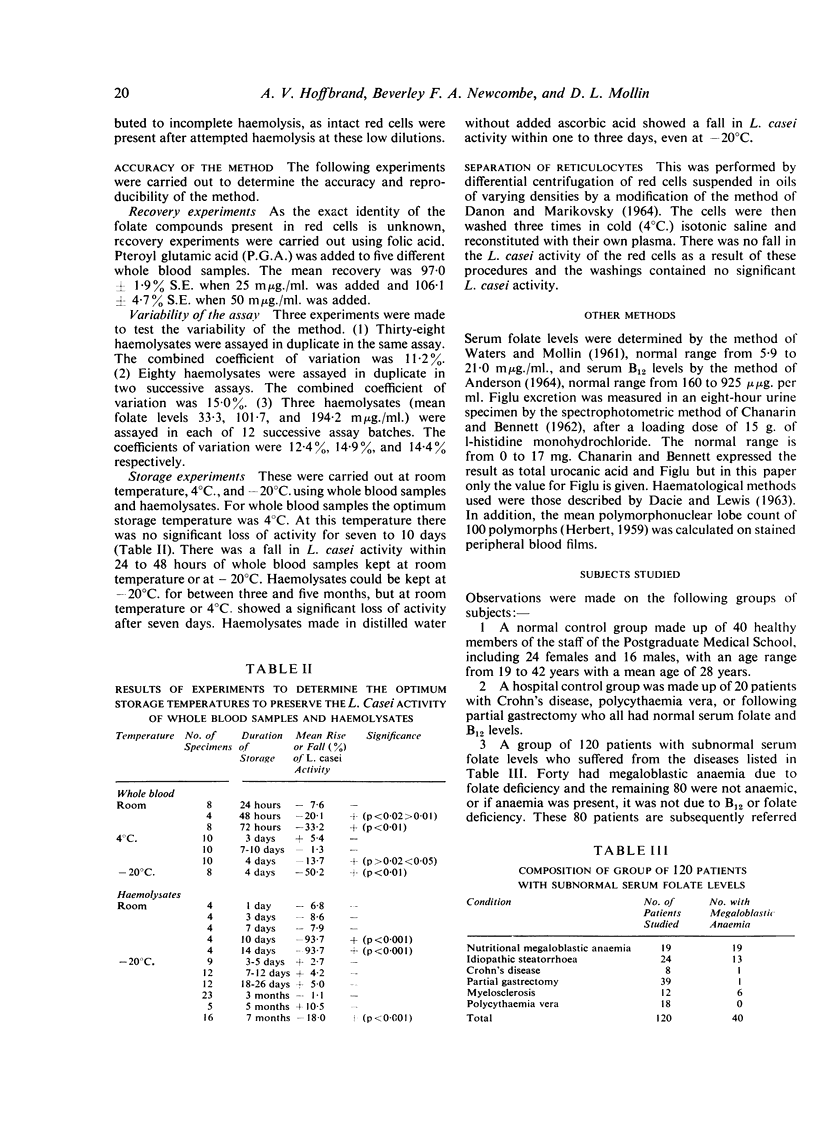
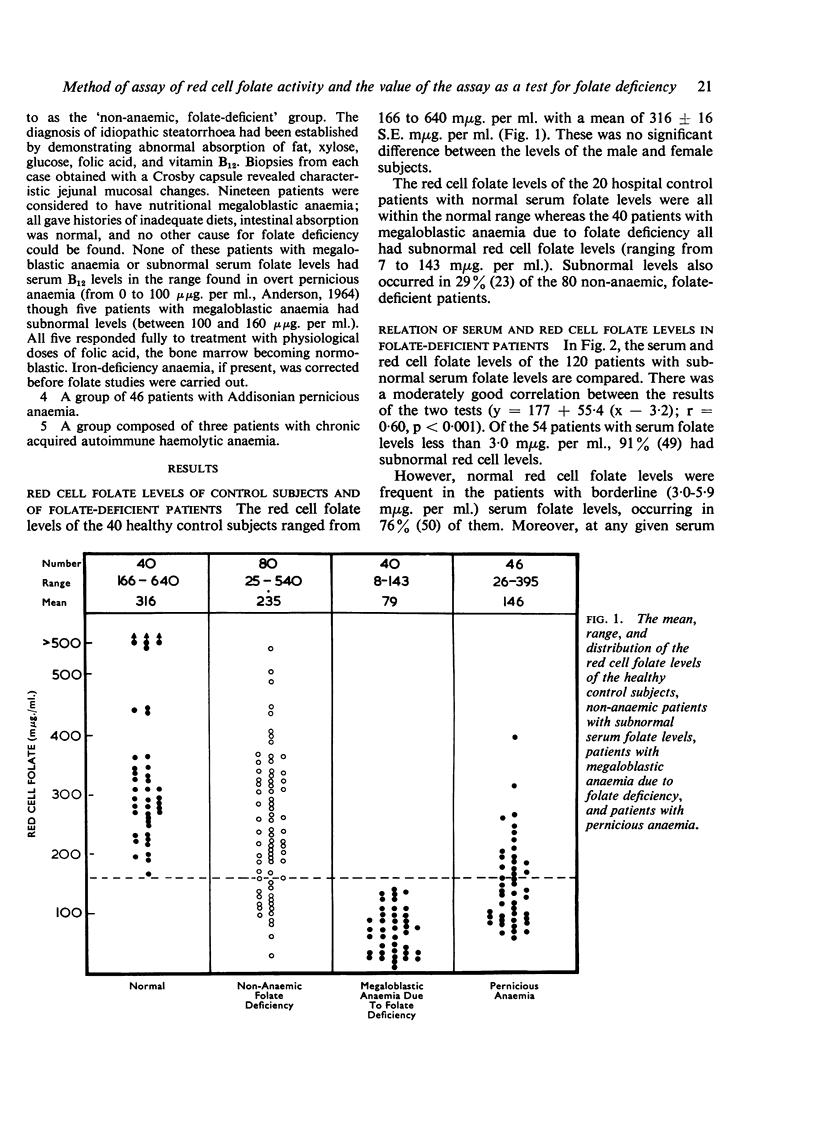
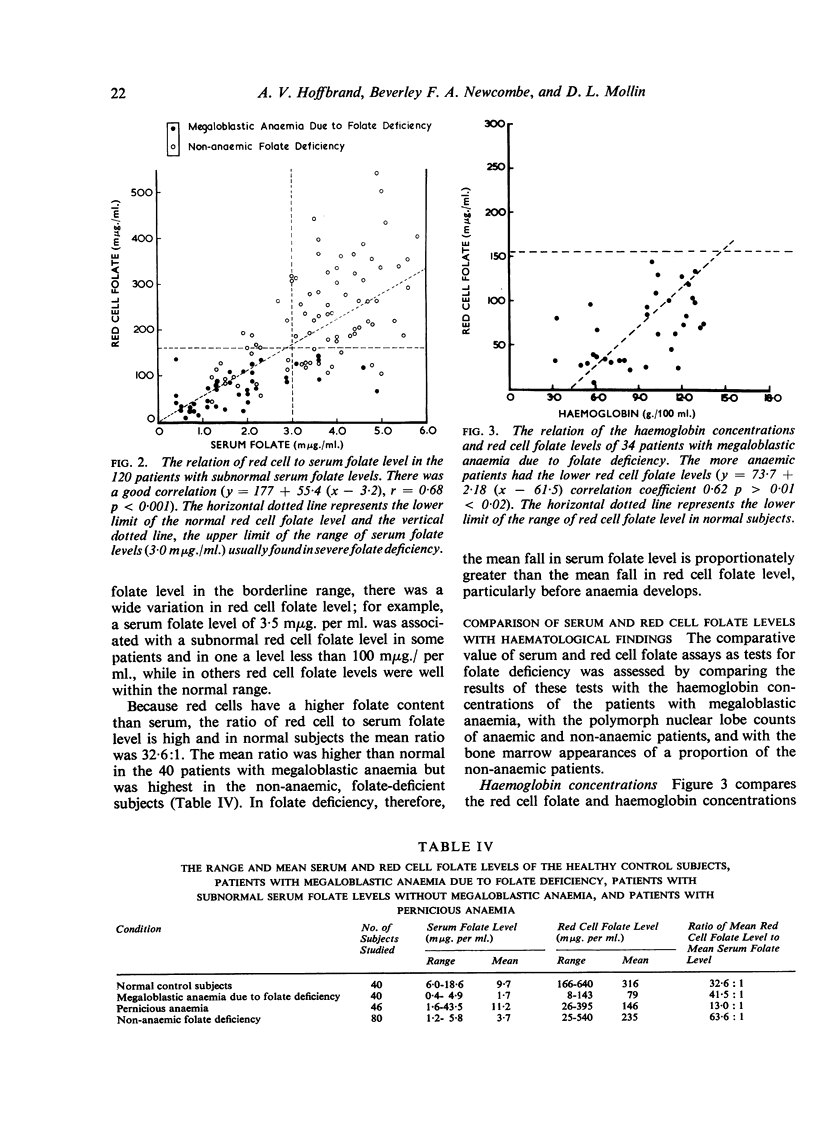
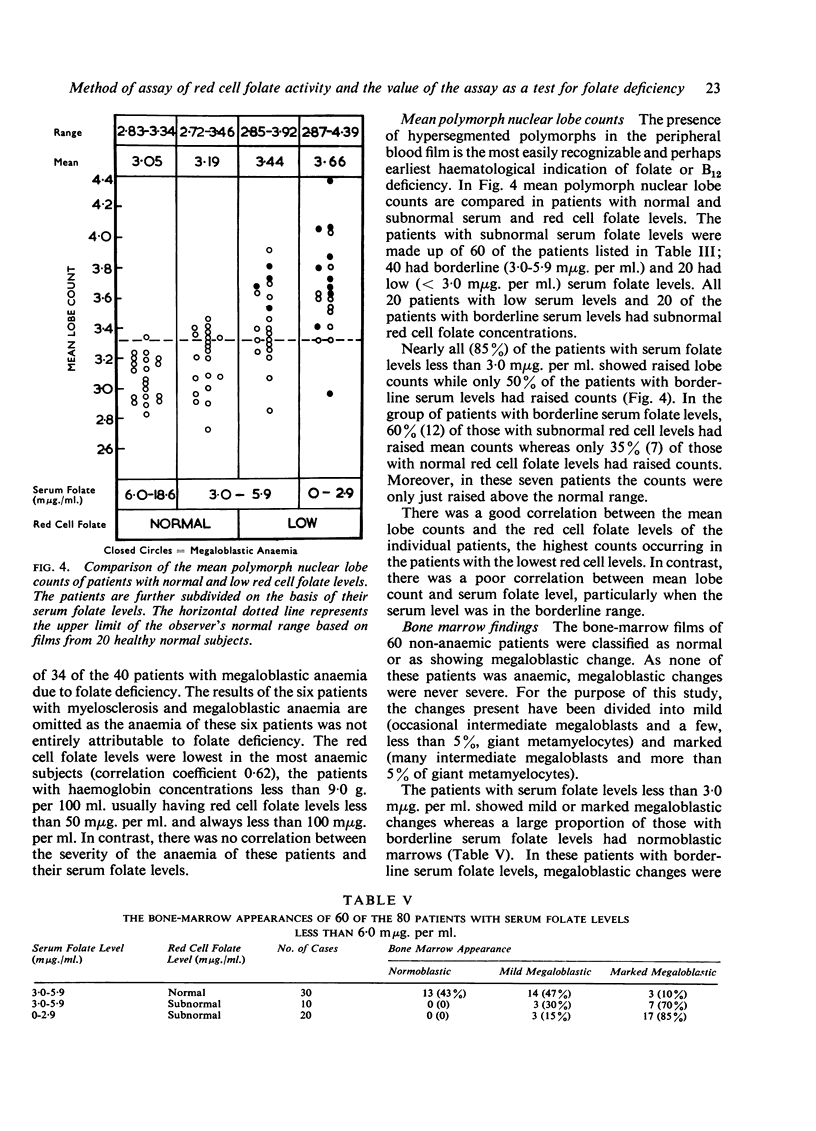
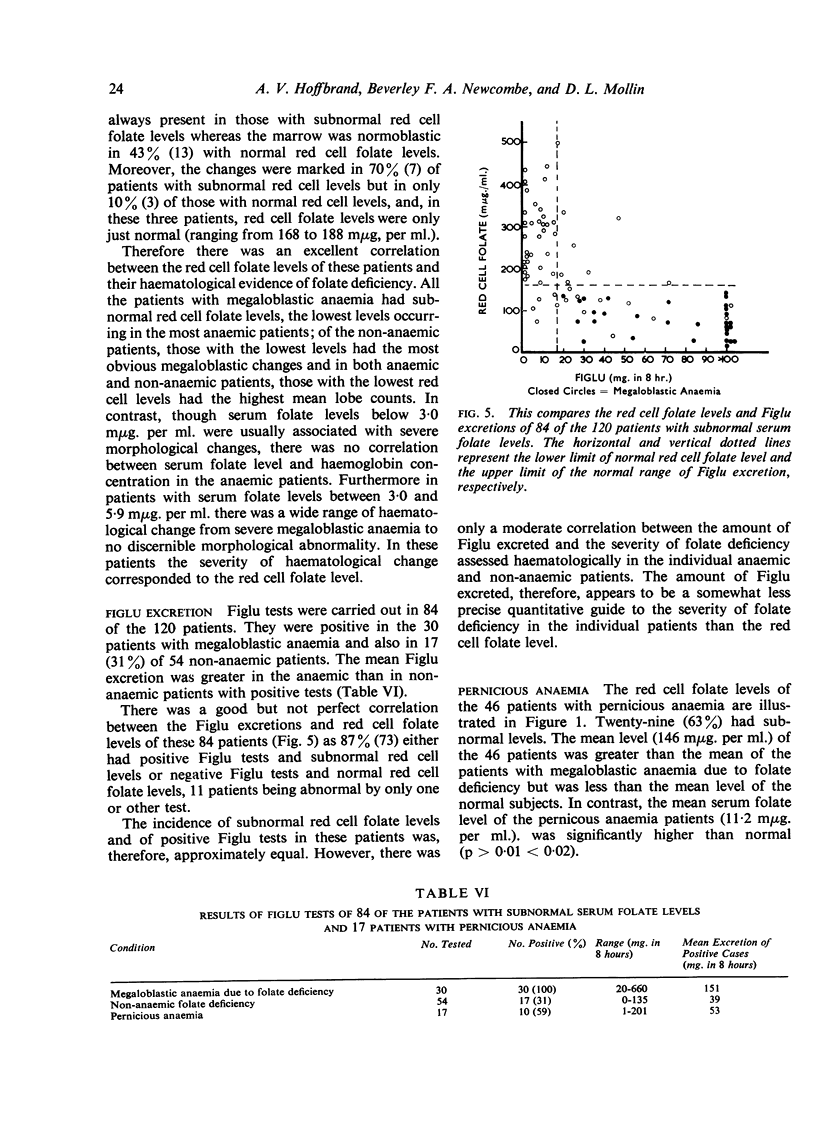
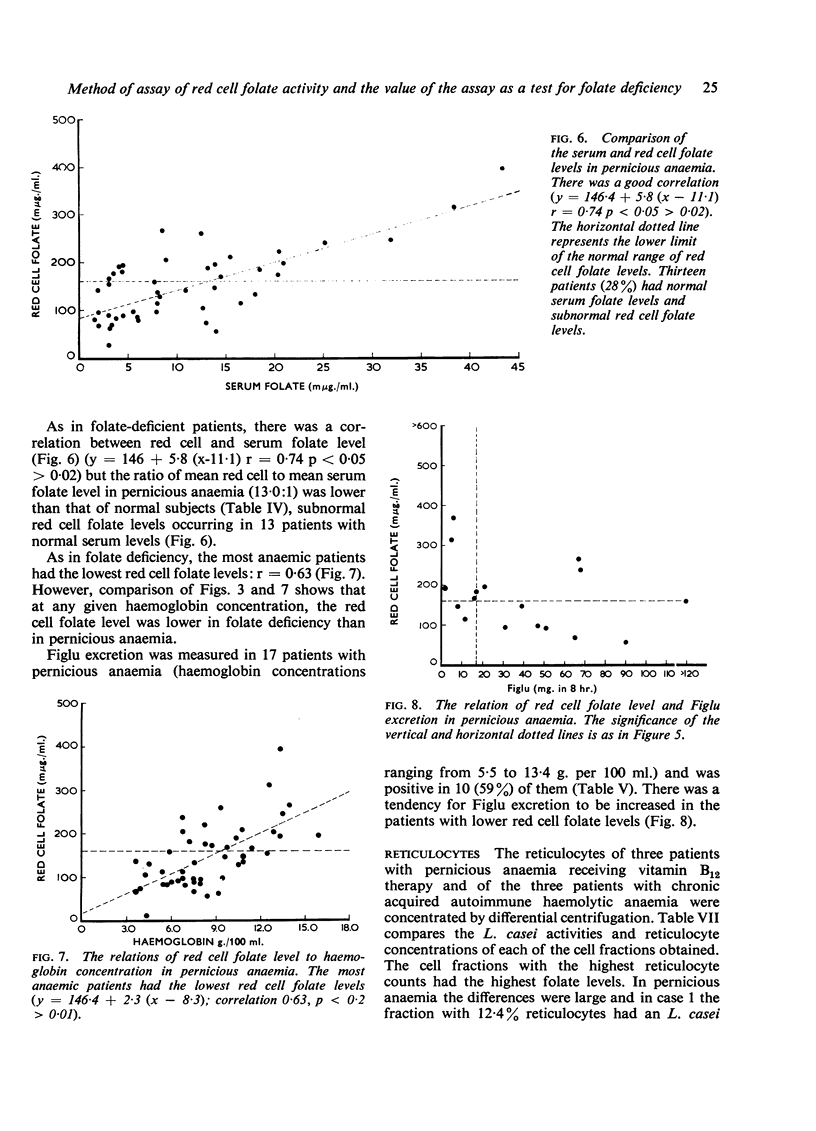
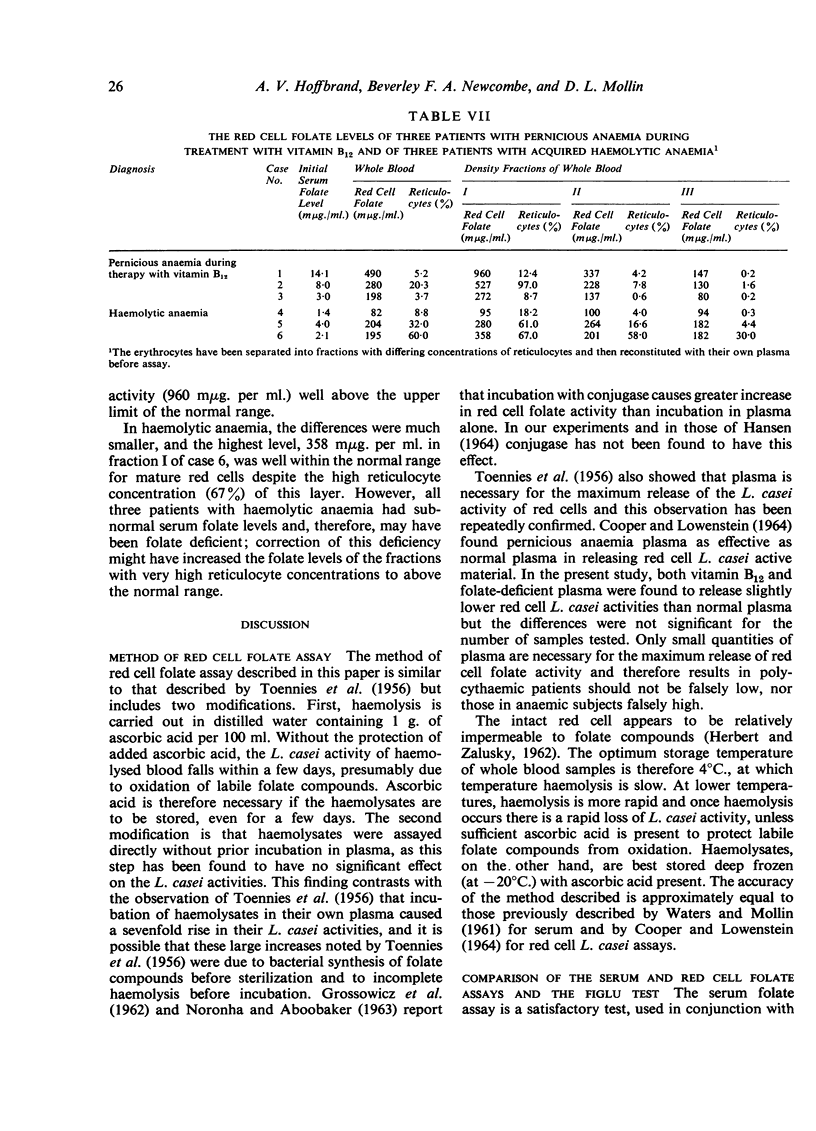
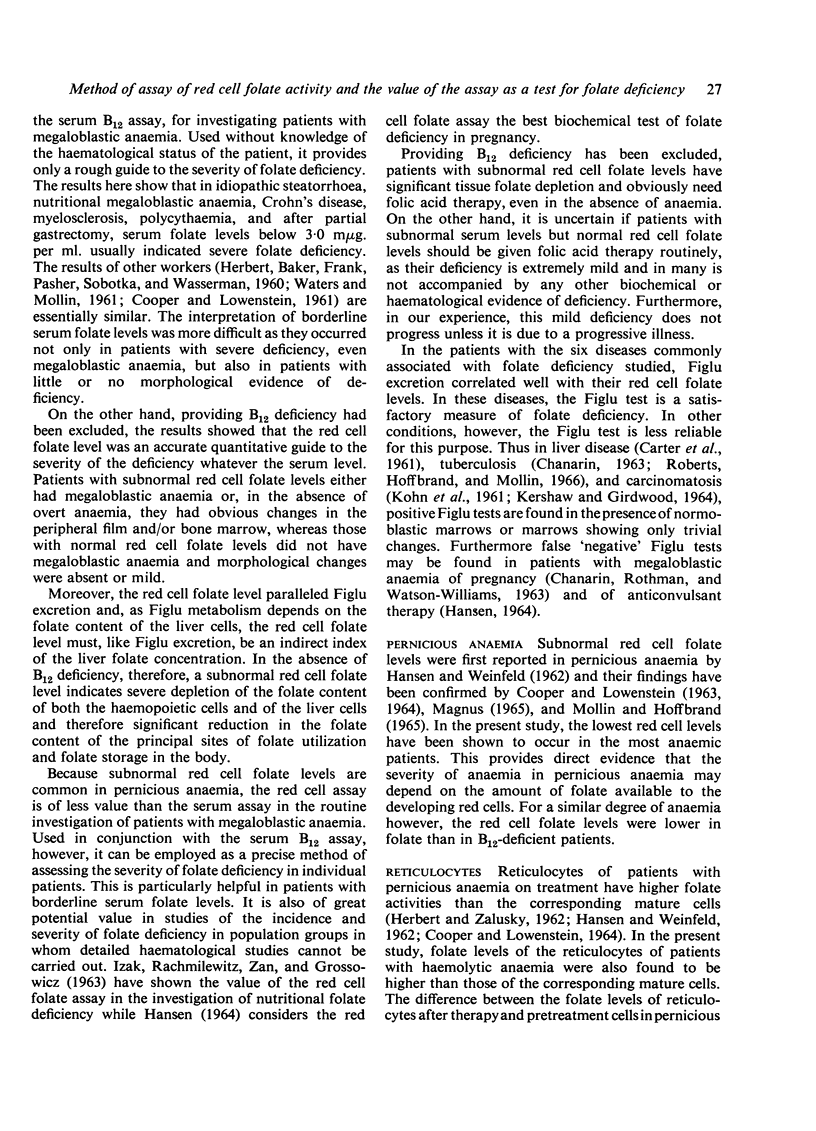
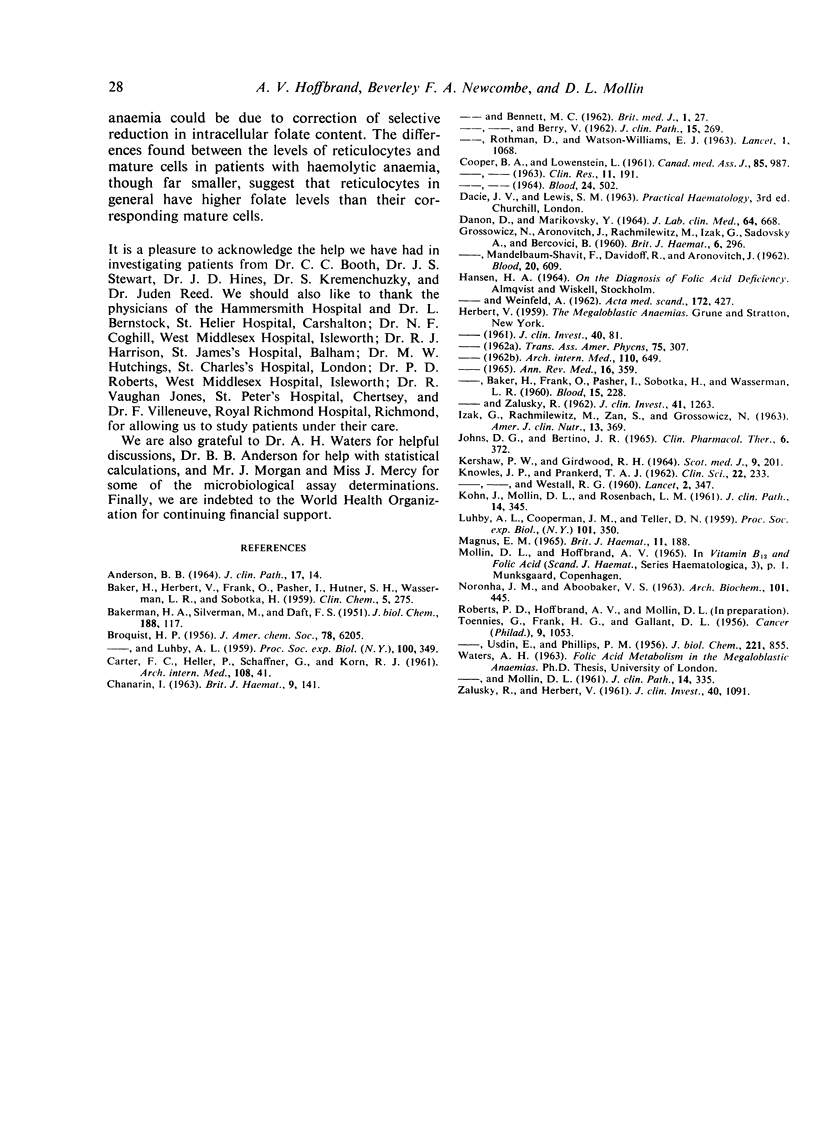
Selected References
These references are in PubMed. This may not be the complete list of references from this article.
- ANDERSON B. B. INVESTIGATIONS INTO THE EUGLENA METHOD FOR THE ASSAY OF THE VITAMIN B12 IN SERUM. J Clin Pathol. 1964 Jan;17:14–26. doi: 10.1136/jcp.17.1.14. [DOI] [PMC free article] [PubMed] [Google Scholar]
- BAKER H., HERBERT V., FRANK O., PASHER I., HUTNER S. H., WASSERMAN L. R., SOBOTKA H. A microbiologic method for detecting folic acid deficiency in man. Clin Chem. 1959 Aug;5(4):275–280. [PubMed] [Google Scholar]
- BAKERMAN H. A., SILVERMAN M., DAFT F. S. Influence of succinylsulfathiazole and folic acid on glutamic acid excretion. J Biol Chem. 1951 Jan;188(1):117–123. [PubMed] [Google Scholar]
- BROQUIST H. P., LUHBY A. L. Detection and isolation of formiminoglutamic acid from urine in folic acid deficiency in humans. Proc Soc Exp Biol Med. 1959 Feb;100(2):349–354. doi: 10.3181/00379727-100-24623. [DOI] [PubMed] [Google Scholar]
- CARTER F. C., HELLER P., SCHAFFNER G., KORN R. J. Formiminoglutamic acid (FIGLU) excretion in hepatic cirrhosis. Arch Intern Med. 1961 Jul;108:41–46. doi: 10.1001/archinte.1961.03620070043006. [DOI] [PubMed] [Google Scholar]
- CHANARIN I. Urocanic acid and formimino-glutamic acid excretion in megaloblastic anaemia and other conditions: the effect of specific therapy. Br J Haematol. 1963 Apr;9:141–157. doi: 10.1111/j.1365-2141.1963.tb05452.x. [DOI] [PubMed] [Google Scholar]
- COOPER B. A., LOWENSTEIN L. Evaluation of assessment of folic-acid deficiency by serum folic-acid activity measured with L. casei. Can Med Assoc J. 1961 Oct 28;85:987–988. [PMC free article] [PubMed] [Google Scholar]
- DANON D., MARIKOVSKY V. DETERMINATION OF DENSITY DISTRIBUTION OF RED CELL POPULATION. J Lab Clin Med. 1964 Oct;64:668–674. [PubMed] [Google Scholar]
- FRANK H. G., GALLANT D. L., TOENNIES G. Blood folic acid activity of normal humans, cancer patients, and noncancer patients; with a few observations on animals. Cancer. 1956 Sep-Oct;9(5):1053–1058. doi: 10.1002/1097-0142(195609/10)9:5<1053::aid-cncr2820090524>3.0.co;2-n. [DOI] [PubMed] [Google Scholar]
- GROSSOWICZ N., ARONOVITCH J., RACHMILEWITZ M., IZAK G., SADOVSKY A., BERCOVICI B. Folic and folinic acid in maternal and foetal blood. Br J Haematol. 1960 Jul;6:296–302. doi: 10.1111/j.1365-2141.1960.tb06246.x. [DOI] [PubMed] [Google Scholar]
- GROSSOWICZ N., MANDELBAUM-SHAVIT F., DAVIDOFF R., ARONOVITCH J. Microbiologic determination of folic acid derivatives in blood. Blood. 1962 Nov;20:609–616. [PubMed] [Google Scholar]
- HANSEN H. A., WEINFELD A. Metabolic effects and diagnostic value of small doses of folic acid and B12 in megaloblastic anemias. Acta Med Scand. 1962 Oct;172:427–443. doi: 10.1111/j.0954-6820.1962.tb07176.x. [DOI] [PubMed] [Google Scholar]
- HERBERT V., BAKER H., FRANK O., PASHER I., SOBOTKA H., WASSERMAN L. R. The measurement of folic acid activity in serum: a diagnostic aid in the differentiation of the megaloblastic anemias. Blood. 1960 Feb;15:228–235. [PubMed] [Google Scholar]
- HERBERT V., ZALUSKY R. Interrelations of vitamin B12 and folic acid metabolism: folic acid clearance studies. J Clin Invest. 1962 Jun;41:1263–1276. doi: 10.1172/JCI104589. [DOI] [PMC free article] [PubMed] [Google Scholar]
- IZAK G., RACHMILEWITZ M., ZAN S., GROSSOWICZ N. THE EFFECT OF SMALL DOSES OF FOLIC ACID IN NUTRITIONAL MEGALOBLASTIC ANEMIA. Am J Clin Nutr. 1963 Dec;13:369–377. doi: 10.1093/ajcn/13.6.369. [DOI] [PubMed] [Google Scholar]
- KERSHAW P. W., GIRDWOOD R. H. SOME INVESTIGATIONS OF FOLIC-ACID DEFICIENCY. Scott Med J. 1964 May;9:201–212. doi: 10.1177/003693306400900503. [DOI] [PubMed] [Google Scholar]
- KNOWLES J. P., PRANKERD T. A. Abnormal folic acid metabolism in vitamin B12 deficiency. Clin Sci. 1962 Apr;22:233–238. [PubMed] [Google Scholar]
- KOHN J., MOLLIN D. L., ROSENBACH L. M. Conventional voltage electrophoresis for formiminoglutamic-acid determination in folic acid deficiency. J Clin Pathol. 1961 Jul;14:345–350. doi: 10.1136/jcp.14.4.345. [DOI] [PMC free article] [PubMed] [Google Scholar]
- LUHBY A. L., COOPERMAN J. M., TELLER D. N. Histidine metabolic loading test to distinguish folic acid deficiency from vit. B12 in megaloblastic anemias. Proc Soc Exp Biol Med. 1959 Jun;101(2):350–352. doi: 10.3181/00379727-101-24936. [DOI] [PubMed] [Google Scholar]
- MAGNUS E. M. FOLIC ACID ACTIVITY IN SERUM AND RED CELLS IN PATIENTS WITH VITAMIN B12 DEFICIENCY: RELATION TO TREATMENT. Br J Haematol. 1965 Mar;11:188–192. doi: 10.1111/j.1365-2141.1965.tb06576.x. [DOI] [PubMed] [Google Scholar]
- PHILLIPS P. M., TOENNIES G., USDIN E. Precursors of the folic acid-active factors of blood. J Biol Chem. 1956 Aug;221(2):855–863. [PubMed] [Google Scholar]
- WATERS A. H., MOLLIN D. L. Studies on the folic acid activity of human serum. J Clin Pathol. 1961 Jul;14:335–344. doi: 10.1136/jcp.14.4.335. [DOI] [PMC free article] [PubMed] [Google Scholar]


